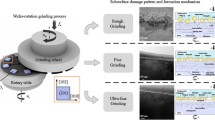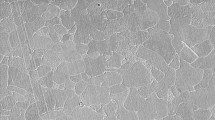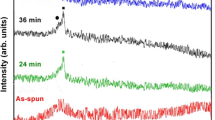Abstract
Cd0.96Zn0.04Te (111) single crystals were ultraprecisely ground by #1500, #3000, and #5000 diamond grinding wheels, and the corresponding surface roughness Ra is 49.132, 18.746, and 5.762 nm. High-resolution field emission scanning electron microscope and transmission electron microscope were employed to investigate the surface and subsurface damage. After ultraprecision grinding by three kinds of diamond wheels, the subsurface can achieve ultra-low damage layer with thickness of 1–2 nm made of amorphous state material and lattice distortion layer. For the #1500 precision grinding, the subsurface damage is mainly multi-nanocrystal with diameter in the range of 5–20 nm. While for the #3000 precision grinding, the subsurface damage is made of amorphous state material containing nanocrystals with diameter mainly in the range of 2–5 nm, and the bending deformation is mainly conducted through dislocation pleat formation. For #5000 ultraprecision grinding, the subsurface damage is mainly amorphous state material, and nanocrystals with diameter in the range of 2–5 nm enrich adjacent to the ground surface. Moreover, the size of nanocrystal ground by #5000 diamond grinding wheel is mainly 2 nm. Fracture mechanism ground by #5000 diamond grinding wheel firstly turns onto thin amorphous state film, then fracture.
Similar content being viewed by others
References
Yin L, Huang H, Ramesh K, Huang T (2005) High speed versus conventional grinding in high removal rate machining of alumina and alumina-titania. Int J Mach Tools Manuf, 45(7–8):897–907
Yin L, Vancoille EYJ, Ramesh K, Huang H, Pickering JP, Spowage AC (2004) Ultraprecision grinding of tungsten carbide for spherical mirrors. Inst Mech Eng Part B J Eng Manuf 218(4):419–429
Yadav SKS, Yadava V, Narayana VL (2008) Experimental study and parameter design of electro-discharge diamond grinding. Int J Adv Manuf Technol 36(1–2):34–42
Heinzel C, Rickens K, Trumpold H (2009) Engineered wheels for grinding of optical glass. Ann CIRP 58(1):315–318
Zhong ZW, Peng ZF (2007) Fractal roughness structures of precision-machined WC-Co- and Inconel 625-coated steel rods. Int J Adv Manuf Technol 33(9–10):885–890
Lee TS, Ting TO, Lin YJ, Htay T (2007) A particle swarm approach for grinding process optimization analysis. Int J Adv Manuf Technol 33(11–12):1128–1135
Jirapattarasilp K, Rukijkanpanich J (2007) The experiment of high-speed grinding of a gemstone: cubic zirconia. Int J Adv Manuf Technol 33(11–12):1136–1142
Teicher U, Ghosh A, Chattopadhyay AB, Kunanz K (2006) On the grindability of Titanium alloy by brazed type monolayered superabrasive grinding wheels. Int J Mach Tools Manuf 46(6):620–622
Tawakoli T, Azarhoushang B (2008) Influence of ultrasonic vibrations on dry grinding of soft steel. Int J Mach Tools Manuf 48(14):1585–1591
Liu Q, Chen X, Gindy N (2007) Assessment of Al2O3 and superabrasive wheels in nickel-based alloy grinding. Int J Adv Manuf Technol 33(9–10):940–951
Schlesinger TE, Toney JE, Yoon H, Lee EY, Brunett BA, Franks L, James RB (2001) Cadmium zinc telluride and its use as a nuclear radiation detector material. Mater Sci Eng R Rep 32(4–5):103–189
Zhang ZY, Meng YW, Guo DM, Kang RK, Gao H (2009) Nanoscale machinability and subsurface damage machined by CMP of soft-brittle CdZnTe crystals. doi:10.1007/s00170-009-2225-2
Zhang ZY, Gao H, Jie WQ, Guo DM, Kang RK, Li Y (2008) Chemical mechanical polishing and nanomechanics of semiconductor CdZnTe single crystals. Semicond Sci Technol 23(10):105023
Kulkarni GA, Sathe VG, Rao KSRK, Muthu DVS, Sharma RK (2009) Micro-Raman imaging of Te precipitates in CdZnTe (Zn similar to 4%) crystals. J Appl Physiol 105(6):063512
Singh R, Velicu S, Crocco J, Chang Y, Zhao J, Almeida LA, Markunas J, Kaleczyc A, Dinan JH (2005) Molecular beam epitaxy growth of high-quality HgCdTe LWIR layers on polished and repolished CdZnTe substrates. J Electron Mater 34(6):885–890
Zeng DM, Jie WQ, Zha GQ, Wang T, Yang G (2007) Effect of annealing on the residual stress and strain distribution in CdZnTe wafers. J Cryst Growth 305(1):50–54
Author information
Authors and Affiliations
Corresponding author
Rights and permissions
About this article
Cite this article
Zhang, Z., Guo, D., Kang, R. et al. Subsurface crystal lattice deformation machined by ultraprecision grinding of soft-brittle CdZnTe crystals. Int J Adv Manuf Technol 47, 1065–1081 (2010). https://doi.org/10.1007/s00170-009-2253-y
Received:
Accepted:
Published:
Issue Date:
DOI: https://doi.org/10.1007/s00170-009-2253-y




